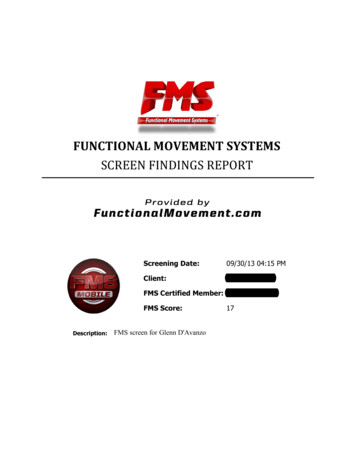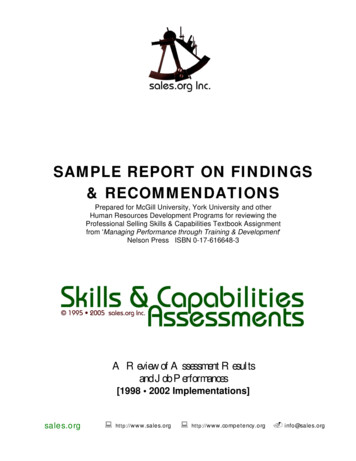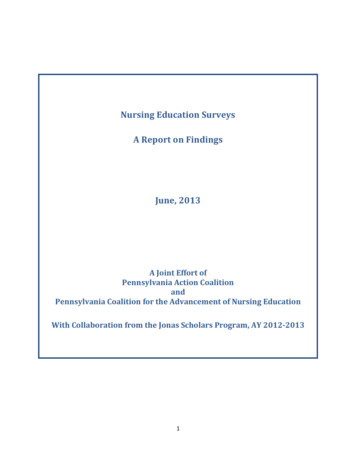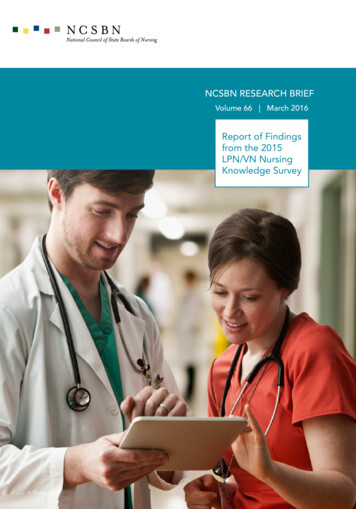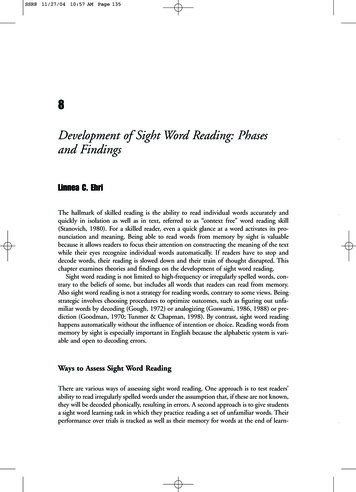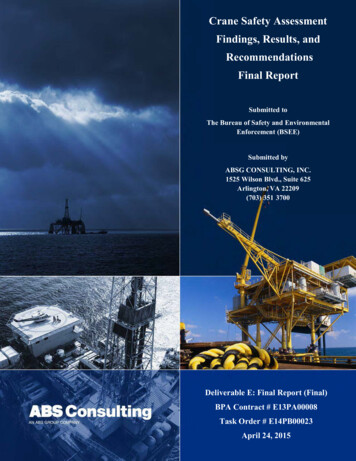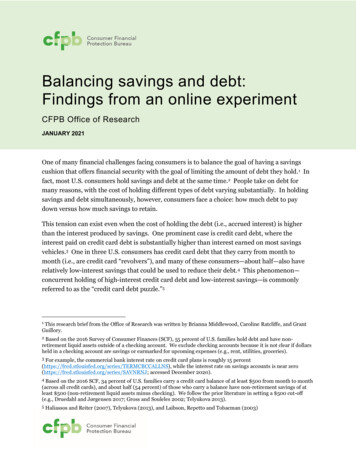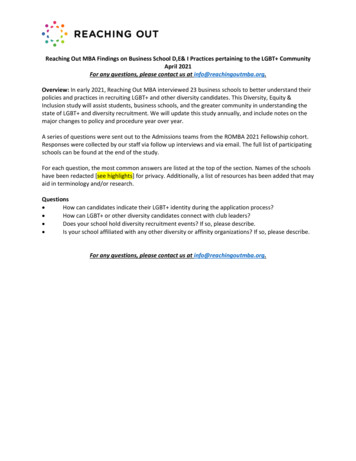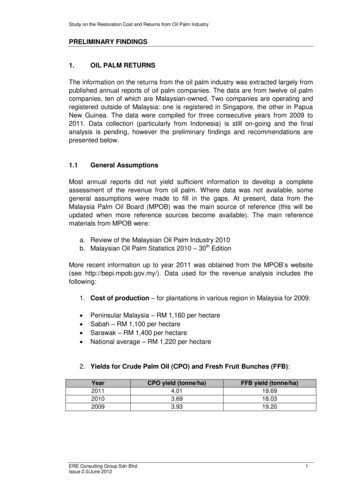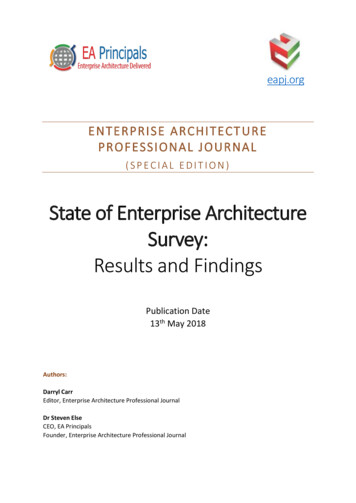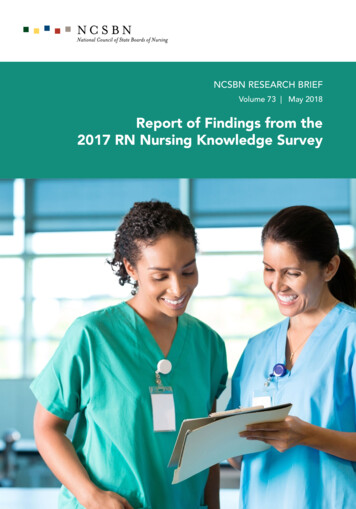
Transcription
NCSBN RESEARCH BRIEFVolume 73 May 2018Report of Findings from the2017 RN Nursing Knowledge Survey
Mission StatementThe National Council of State Boards of Nursing (NCSBN ) provides education, service and research through collaborativeleadership to promote evidence-based regulatory excellence for patient safety and public protection.Copyright 2018 National Council of State Boards of Nursing, Inc. (NCSBN )All rights reserved. NCSBN , NCLEX , NCLEX-RN , NCLEX-PN , NNAAP , MACE , Nursys and TERCAP are registeredtrademarks of NCSBN and this document may not be used, reproduced or disseminated to any third party without written permission from NCSBN.Permission is granted to boards of nursing to use or reproduce all or parts of this document for licensure related purposesonly. Nonprofit education programs have permission to use or reproduce all or parts of this document for educationalpurposes only. Use or reproduction of this document for commercial or for-profit use is strictly prohibited. Any authorizedreproduction of this document shall display the notice: “Copyright by the National Council of State Boards of Nursing,Inc. All rights reserved.” Or, if a portion of the document is reproduced or incorporated in other materials, such writtenmaterials shall include the following credit: “Portions copyrighted by the National Council of State Boards of Nursing,Inc. All rights reserved.”Address inquiries in writing to NCSBN Permissions, 111 E. Wacker Drive, Suite 2900, Chicago, IL 606014277. Suggested Citation: National Council of State Boards of Nursing. (2018). Report of Findings from the2017 RN Nursing Knowledge Survey. Chicago: Author.Printed in the United States of AmericaISBN# 978-0-9903603-9-1
Report of Findings from the2017 RN Nursing Knowledge SurveyNational Council of State Boards of Nursing, Inc. (NCSBN )
TABLE OF CONTENTSiTABLE OF CONTENTSList of Tables iiList of Figures iiExecutive Summary 1Background of Study 7Methodology 7Methodology Reviewers 7Panel of Subject Matter Experts (SMEs) 7Survey Development 7Survey Process 8Sample Selection 8Representativeness 8Mailing Procedure 8Confidentiality 10Return Rates 10Knowledge Survey Nonresponder Study 11Summary 11Demographics, Experiences and Practice Environments of Participants 12Demographics/Past Experiences 12Nursing Licenses Held 12Gender 12Age 12Race/Ethnicity 12Education Background 12Primary Language 12Years of Experience 12Facilities 14Client Health Conditions 14Client Ages 14Employment Setting/Specialty 19Summary 19Knowledge Statement Findings 20Overview of Methods 20SME Panel Validation of Survey Findings 20Representativeness of Knowledge Statements 20Reliability of Instrument 20Knowledge Statements 22Importance of Knowledge Statements 22Knowledge Statement Subgroup Analysis 34Primary Job Title 34Facility 34Summary 34Conclusions 34National Council of State Boards of Nursing, Inc. (NCSBN) 2018
iiTABLE OF CONTENTSReferences 35Appendix A: 2017 Knowledge Survey Methodology Reviewers 36Appendix B: SME Panel for the 2017 Knowledge of Newly Licensed RN Survey 37Appendix C: 2017 Knowledge of Newly Licensed RN Survey 40Appendix D: SME Knowledge Statement Ratings Rank Ordered by Average Importance 48Appendix E: Newly Licensed RN and SME Knowledge Statement Ratings Rank Ordered by NewlyLicensed RN Average Importance 56Appendix F: RN Educators and SME Knowledge Statement Ratings Rank Ordered by RN EducatorAverage Importance 64Appendix G: RN Supervisors and SME Knowledge Statement Ratings Rank Ordered by RNSupervisor Average Importance 72Appendix H: Knowledge Statements Subgroup Analysis: Primary Job Title 80Appendix I: Knowledge Statements Subgroup Analysis: Facility 92Appendix J: Knowledge Survey Nonresponder Study 101Appendix K: Linking of Knowledge Statements and Activity Statements 104LIST OF TABLESTable 1. Representativeness of Responders by NCSBN Jurisdiction 9Table 2. Return Rates 11Table 3. Analyzable Return Rates 11Table 4. Employment Setting/Specialty 17Table 5. Most Important and Least Important Knowledge Statements with Ratings 22Table 6. Most Important Knowledge Statements from 2017 and 2014 Surveys 23Table 7. Least Important Knowledge Statements from 2017 and 2014 Surveys 23Table 8. Knowledge Statement Importance Ratings 24LIST OF FIGURESFigure 1. Licenses by Primary Job Title . . . . . . . . . . . . . . . . . . . . . . . . . . . . . . . . . . . . . . . . . . . . . . . . . . 13Figure 2. Gender by Primary Job Title. . . . . . . . . . . . . . . . . . . . . . . . . . . . . . . . . . . . . . . . . . . . . . . . . . . 13Figure 3. Race/Ethnicity by Primary Job Title . . . . . . . . . . . . . . . . . . . . . . . . . . . . . . . . . . . . . . . . . . . . . 14Figure 4. Educational Background by Primary Job Title . . . . . . . . . . . . . . . . . . . . . . . . . . . . . . . . . . . . . 15Figure 5. Primary Language by Primary Job Title . . . . . . . . . . . . . . . . . . . . . . . . . . . . . . . . . . . . . . . . . . 15Figure 6. Facility by Primary Job Title . . . . . . . . . . . . . . . . . . . . . . . . . . . . . . . . . . . . . . . . . . . . . . . . . . . 16Figure 7. Client Health Conditions by Primary Job Title. . . . . . . . . . . . . . . . . . . . . . . . . . . . . . . . . . . . . 16Figure 8. Client Ages by Primary Job Title. . . . . . . . . . . . . . . . . . . . . . . . . . . . . . . . . . . . . . . . . . . . . . . . 17Figure 9. Survey Adequacy by Primary Job Title. . . . . . . . . . . . . . . . . . . . . . . . . . . . . . . . . . . . . . . . . . . 21National Council of State Boards of Nursing, Inc. (NCSBN) 2018
EXECUTIVE SUMMARYEXECUTIVE SUMMARYThe National Council of State Boards of Nursing(NCSBN ) is responsible to its members, the boardsof nursing in the U.S. and member board territoriesfor the preparation of psychometrically sound andlegally defensible licensure examinations (AmericanEducational Research Association, AmericanPsychological Association and National Council onMeasurement in Education, 2014). Practice analysis(i.e., job analysis) studies assist NCSBN in evaluatingthe validity of the test plan that guides contentdistribution of the licensure examinations. Becausethe U.S. health care industry is rapidly changing,NCSBN conducts practice analysis studies everythree years.The primary purpose of this study is to identify theknowledge needed by newly licensed registerednurses (RNs). The results of this study will be used toinform item development.MethodologyA number of steps are necessary to performan analysis of the knowledge needed by newlylicensed RNs. This section provides a description ofthe methodology used to conduct the 2017 Knowledge of Newly Licensed Registered Nurse (RN)Survey. A panel of subject matter experts (SMEs)was assembled, a list of knowledge statements wascreated and incorporated into a survey that wassent to a representative sample of Newly LicensedRNs, RN Educators and RN Supervisors, and thesurvey data was collected and analyzed. Descriptions of the subject matter expert panel processes,survey development, sample selection and datacollection procedures are provided, as well as information about confidentiality, response rates and thedegree to which participants were representative ofthe sample of Newly Licensed RNs, RN Educatorsand RN Supervisors. This report provides detaileddescriptions of these processes.Methodology ReviewersThree methodology reviewers, chosen for theirpsychometric expertise in practice/job analysisand certification exam development, reviewed themethodologies and procedures utilized in this study.1All three reviewers indicated this methodology waspsychometrically sound, legally defensible and incompliance with professional testing standards.Panel of Subject Matter Experts (SMEs)A panel of 11 SMEs was assembled to assist withthe creation of the knowledge statements and survey. Panel members taught RN students, supervisednewly licensed RNs or were newly licensed RNsthemselves. The panelists also represented variousNCSBN geographic areas of the U.S. and Canadianterritories/jurisdictions, as well as the major nursingspecialties and varied practice settings.Survey DevelopmentA number of processes were used to create, evaluate, and refine the survey instrument used for the2017 Knowledge of Newly Licensed RN Survey. Theinitial meetings for the triennial practice analysispreceded the development of the 2017 RN Nursing Knowledge Survey. An initial panel of nurses(SMEs), representing various geographic regions ofthe U.S. and Canada, nursing specialties and practice settings, developed nursing activity statementsintended to represent entry-level RN practice.These activity statements and related categoriesprovided a structure for the creation of the knowledge statements. Following the work of the firstpanel, a second group of SMEs was convened withtwo panelists bridging the two groups.This second panel reviewed the activity statementsand then developed knowledge statements foreach. The knowledge statements were reviewedby the NCLEX Examination Committee (NEC). Theresulting 295 knowledge statements were incorporated into a survey format.The final page of the survey contained several initial questions to identify responder characteristics,followed by four sections. The first section focusedon the knowledge necessary for entry-level RNpractice, asking responders to rate the importanceof each knowledge statement by using a five-point(1-5) scale. Section two identified the participant’swork environment including area of practice, typeof client and employment setting/specialty. Sectionthree focused on demographic information, such asNational Council of State Boards of Nursing, Inc. (NCSBN) 2018
2EXECUTIVE SUMMARYrace/ethnicity, highest obtained education degreeand gender. The final section provided space forresponders to write comments or suggestionsabout the survey.RepresentativenessSurvey ProcessMailing ProcedureSample SelectionNewly Licensed RNs: A random sample of 2,150RNs was selected from a list of candidates whopassed the NCLEX-RN examination betweenApril 15, 2016 and March 15, 2017 and did not participate in the RN Practice Analysis Survey. Onlythose with a U.S. mailing address within the jurisdiction in which they were seeking licensure wereincluded in the sample in order to minimize thenumber of incorrect recipient addresses.Educators of RNs (RN Educators): In addition,surveys were sent to 2,100 nursing educators at700 different nursing programs using the following methodology. Three surveys were sent toeach dean/director of 700 nursing programs, withinstructions for them to distribute one survey to(1) a Medical/Surgical Nursing instructor; (2) anObstetrics-Gynecology/Pediatric or Maternal ChildNursing instructor; and (3) a Psychiatric (MentalHealth) or Community Health Nursing instructor.Each of the programs in the sample had a minimumof nine NCLEX candidates within the last calendaryear (2016).Supervisors of Newly Licensed RNs (RN Supervisors): Finally, 2,100 employers (700 in nursinghomes; 700 in hospitals; and 700 in home healthagencies) of newly licensed RNs were surveyed. Theselection of employers to be included in the surveywas also based upon the number of RNs employed(at least nine RN employees). This criterion wasapplied in order to maximize the likelihood thatthe employer would have newly licensed RNs andsupervisors of newly licensed RNs. Surveys weremailed to the directors of nursing (DONs) or equivalent, who were asked to complete the survey if theydirectly supervised newly licensed RNs. If they didnot supervise newly licensed RNs, the DONs wereasked to give the survey to a nurse who did.The percentage of responders from the various NCSBN jurisdictions is similar to the samplecomposition.The survey forms were mailed to a total of 6,350potential responders: 2,150 Newly Licensed RNs,2,100 RN Educators and 2,100 potential supervisorsof newly licensed RNs. To acquire the RN Educatorresponders, three surveys were sent to the dean/director of the program to distribute amongst theirstaff. It was requested that a survey be distributedto an educator in each of the following generalareas: (1) Medical/Surgical Nursing; (2) ObstetricsGynecology/Pediatric or Maternal Child Nursing;and (3) Psychiatric (Mental Health) or CommunityHealth Nursing. If the school did not have specificfaculty to complete the survey, it was asked thatadditional faculty in the clinical setting who teachMedical/Surgical participate.A five-stage mailing process was used to engagethe participants in the study. A pre-survey letterwas mailed to each person or facility, followed bythe survey(s), with a cover letter and a postage-paidreturn envelope, one week later. A series of threereminder postcards were sent to nonrespondersreiterating the importance of the study and urgingparticipation. The survey was conducted from Aprilthrough June 2017.Thirty-two surveys were returned undeliverable dueto incorrect addresses. These returned surveys werereplaced with additional survey invites to maintain atotal number of surveys of 6,350.ConfidentialityAll potential participants were promised confidentiality with regard to their participation andresponses. Pre-assigned code numbers were usedto facilitate follow-up mailings. Files containingmailing information were kept separate from thedata files. The study protocol was approved byNCSBN’s Chief Executive Officer for co
2017 Knowledge of Newly Licensed RN Survey The initial meetings for the triennial practice analysis preceded the development of the 2017 RN Nurs-ing Knowledge Survey An initial panel of nurses (SMEs), representing various geographic reg
